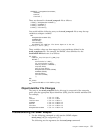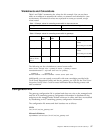
VARIABLES { managementServerName,
nodeName,
eventID,
alertText }
These are denoted in the tecad_snmp.cds file as follows:
3:ATTR(=,"managementServerName");
4:ATTR(=,"nodeName");
5:ATTR(=,"eventID");
6:ATTR(=,"alertText");
You would add the following entry to the tecad_snmp.cds file to map the trap
variables to adapter variables:
MAP
managementServerName=$V3;
nodeName=$V4;
eventID=$V5;
alertText=$V6;
msg=PRINTF("The LANAlert File Server Agent on %s has set
a priority 1 alert.",$V4);
These variable values are then mapped to event attributes defined in the
tecad_snmp.baroc file. For example, the BAROC class definition for the
lanalertFSA-NW3-s1 event is as follows:
TEC_CLASS :
LANAlert_Trap ISA Specific_SNMP_Trap
DEFINES {
source:default="LANA";
sub_source:default="NET";
severity:default="WARNING";
trapTime:INT32;
specificTrap:INT32;
managementServerName:STRING;
nodeName:STRING;
eventID:INT32;
alertText:STRING;
};
END
TEC_CLASS :
lanalertFSA-NW3-s1 ISA LANAlert_Trap;
END
Object Identifier File Changes
The entry in the tecad_snmp.oid file for this trap is composed of the enterprise
prefix plus the appropriate object identifiers (OID) plus the variable attribute OID.
For example,
#nci 1.3.6.1.4.1.768
lanalert 1.3.6.1.4.1.768.2
lanalert-data 1.3.6.1.4.1.768.2.2
nodeName 1.3.6.1.4.1.768.2.2.2
eventID 1.3.6.1.4.1.768.2.2.3
alertText 1.3.6.1.4.1.768.2.2.5
managementServerName 1.3.6.1.4.1.768.2.2.6
Troubleshooting the SNMP Adapter
1. Use the following command to cold start the SNMP adapter:
tecad_snmp [–d][–c configuration_file]
The following are the arguments for the tecad_snmp command:
Chapter 7. SNMP Adapter 93


















